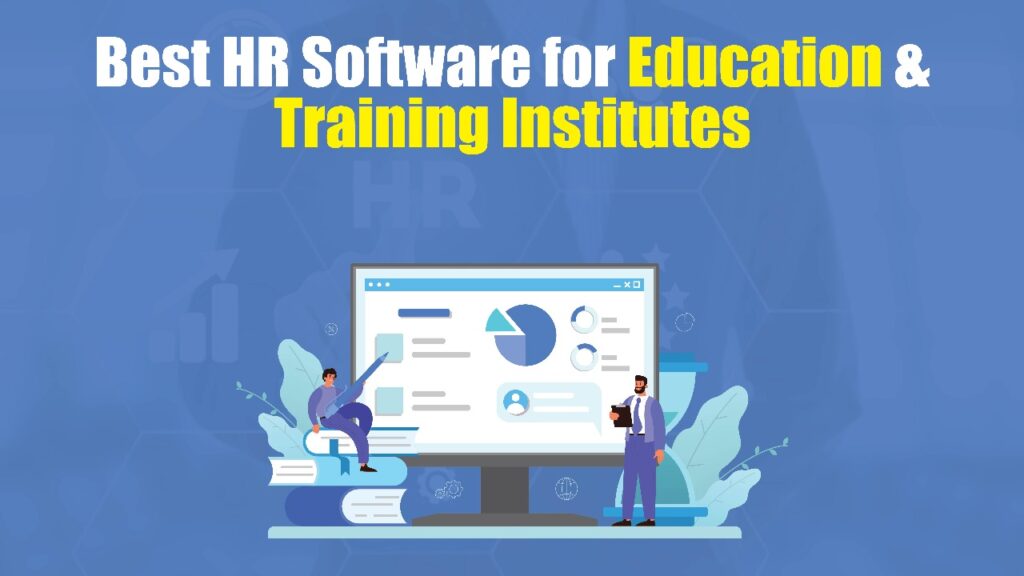What Is Education HR Software?
Education HR software is a system that helps schools, colleges, and training institutes manage payroll, recruitment, attendance, performance, and certifications. It centralizes employee data, automates workflows, and ensures compliance with labor laws. Staff and HR teams can access records anytime, reducing manual errors and improving efficiency. By providing a unified platform for administrative and HR operations, these tools improve staff productivity, reduce operational costs, and maintain consistency across campuses.
Benefits of Education HR Software
- Centralized Access – HR teams, managers, and staff can access records and payroll from any device.
- Automation of Tasks – Attendance, payroll, leave requests, and scheduling are automated to save time.
- Compliance Tracking – Licenses, certifications, and labor law compliance are monitored automatically.
- Performance Insights – Dashboards provide real-time reporting for employee performance.
- Employee Self-Service – Staff can request leave, view payslips, and update personal info online.
How Does Education HR Software Work?
- Stores Employee Data Securely – Payroll, performance, and credential info are centralized.
- Automates HR Workflows – Repetitive tasks like scheduling and payroll are automated.
- Real-Time Sync – Updates are reflected immediately across the system.
- Dashboard Access – Web and mobile dashboards give HR and staff a clear view of tasks.
- Integrates With Other Systems – Connects to payroll, finance, and communication tools.
Best HR Software for Education & Training Institutes in 2026
1) Yomly
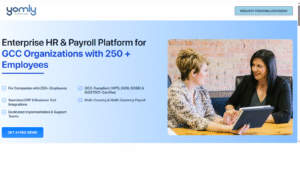
Overview
Yomly is a cloud-based HR and payroll platform designed for large educational institutions with 250+ employees. It helps universities and schools automate HR processes, manage multi-campus operations, and stay compliant with local labor laws. The platform centralizes employee data, attendance, payroll, and performance management in one secure system. With mobile self-service tools, staff can easily access payslips, leave requests, and HR documents. Yomly is trusted by over 250 companies in 50+ countries.
Key Features
- Centralizes HR management for faculty, administration, and support staff.
- Automates payroll with WPS compliance and multi-currency support.
- Tracks attendance and leave through mobile apps or biometric systems.
- Conducts structured performance reviews aligned with institutional goals.
- Stores contracts, visas, and employee records securely with automated alerts.
Pros
- Reduces manual HR workload significantly.
- Seamless multi-campus management.
- Staff self-service enhances engagement.
- Full compliance with labor laws.
- Scalable for large institutions.
Cons
- Best suited for large institutions; may be complex for smaller schools.
- Setup and customization may require time.
- Pricing requires consultation.
- Advanced analytics may need configuration.
- Interface may feel complex for first-time users.
Pricing
- Tailored for institutions with 250+ employees.
- Contact sales for a customized proposal.
- Includes HR, payroll, compliance, and attendance tools.
- Demo available for evaluation before purchase.
- Cost varies based on modules and campus size.
Why Choose?
Yomly is ideal for multi-campus universities that need a centralized HR solution. It automates payroll, attendance, and leave processes, reducing manual errors. Compliance with labor laws is fully supported, and staff enjoy a seamless digital experience. The platform provides enterprise-level security and ensures that HR teams can manage large teams efficiently. Overall, it simplifies HR administration while improving employee engagement.
2) Easy HR
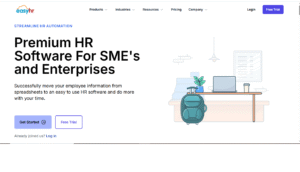
Overview
Easy HR is a user-friendly HR software designed for schools, colleges, and mid-sized universities. It helps automate payroll, attendance, performance tracking, and staff management in one platform. The modular design allows institutions to select features suited to their needs. It enhances communication between departments and improves transparency for staff. Easy HR focuses on reducing administrative workload while increasing efficiency and engagement.
Key Features
- Manages staff records, documents, and profiles securely.
- Automates payroll calculations, deductions, and payslip generation.
- Simplifies attendance tracking via biometric integration.
- Supports performance evaluations and workforce competency tracking.
- Integrated notice board and HR helpdesk for quick communication.
Pros
- Reduces manual HR tasks.
- Flexible and modular design for schools and universities.
- Mobile access for HR and staff convenience.
- Improves communication between departments.
- Enhances staff engagement and transparency.
Cons
- Pricing requires contacting the company.
- Limited global compliance support.
- Some modules may take time to implement.
- May not scale well for very large universities.
- Custom integrations may require extra effort.
Pricing
- Contact Easy HR for institution-specific pricing.
- Includes HR, payroll, attendance, and performance modules.
- Demo available for feature evaluation.
- Cost depends on staff size and selected modules.
- Add-ons available for advanced analytics and reporting.
Why Choose?
Easy HR is perfect for mid-sized institutions seeking a simple, modular HR solution. It reduces manual HR work and improves communication between departments. Automation in payroll and attendance enhances efficiency. Staff engagement is improved with self-service tools. The platform is flexible enough to grow as the institution expands.
3) SAP SuccessFactors
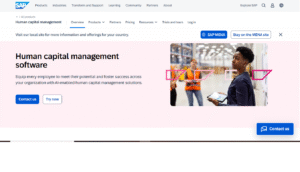
Overview
SAP SuccessFactors is an enterprise-grade HR solution for universities and research institutions. It integrates HR, payroll, finance, analytics, and grants management into one platform. The software helps create “smart campuses” by connecting human capital management with administrative workflows. Institutions like the University of Toronto have centralized operations, improved reporting, and streamlined decision-making. SuccessFactors is scalable for multi-campus and global education providers.
Key Features
- Centralizes HR, payroll, and compliance for large institutions.
- Supports multi-campus and multi-currency operations.
- Performance and learning modules track faculty development.
- Integrates HR data with finance and student systems.
- AI-driven analytics optimize workforce planning and reporting.
Pros
- Streamlines multi-campus HR operations.
- Advanced analytics for data-driven decisions.
- Enhances staff learning and development.
- Improves reporting and operational efficiency.
- Scalable for global institutions.
Cons
- High cost; suitable mainly for large institutions.
- Implementation is complex and time-consuming.
- Requires IT support for full integration.
- Staff training needed for advanced modules.
- Some features may be too advanced for smaller schools.
Pricing
- Customized enterprise pricing based on institution size.
- Includes HR, payroll, performance, and learning modules.
- Contact SAP for a demo and detailed proposal.
- Cost varies depending on integrations and campus count.
- Enterprise support included in subscription.
Why Choose?
SAP SuccessFactors is ideal for universities that need deep integration of HR with finance and student systems. It streamlines multi-campus operations and ensures compliance across locations. AI-driven insights help administrators optimize workforce planning. Performance and learning tools enhance staff development. Overall, it reduces administrative burden and improves institutional efficiency.
4) BambooHR
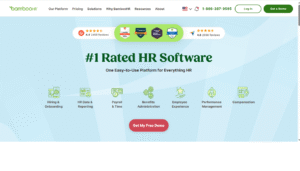
Overview
BambooHR is an all-in-one HR software designed for mid-sized schools and universities. It focuses on simplifying HR tasks while keeping costs manageable. The platform combines payroll, recruiting, time-off management, and performance tracking into a single system. Schools like KIPP Nashville have used it to improve staff satisfaction and save time for educators. BambooHR provides a centralized platform for all HR data, enabling better decision-making.
Key Features
- Streamlines recruiting with multi-platform job posting and offer letters.
- Simplifies onboarding and pre-boarding for new hires.
- Tracks teaching credentials, certifications, and substitute availability.
- Centralizes payroll, time-off requests, and benefits management.
- Mobile app allows staff to submit leave requests and access HR updates.
Pros
- Affordable for mid-sized institutions.
- Consolidates multiple HR functions in one platform.
- Mobile access improves staff convenience.
- Enhances staff satisfaction with eNPS surveys.
- Simplifies recruiting and onboarding processes.
Cons
- Limited advanced analytics for very large institutions.
- Payroll customization may be basic for complex setups.
- Certain integrations require additional setup.
- Not ideal for very large multi-campus universities.
- Some users report a learning curve for advanced features.
Pricing
- Custom pricing depending on institution size.
- Includes HR, payroll, recruiting, and performance modules.
- Mobile access included.
- Demo available for evaluation.
- Add-ons for advanced reporting available.
Why Choose?
BambooHR is ideal for mid-sized schools seeking an affordable, all-in-one HR solution. It simplifies recruiting, payroll, and performance management. Staff enjoy mobile access and easier communication. Administrators gain centralized visibility of HR data. Overall, it improves efficiency without overwhelming smaller institutions.
5) Zoho People
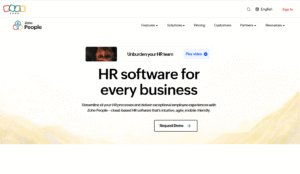
Overview
Zoho People is a flexible HR software suitable for schools, colleges, and universities. It allows institutions to configure workflows, policies, and permissions according to their unique requirements. The platform handles attendance, shifts, allowances, and performance management, keeping employee data secure. Built-in communication tools ensure smooth coordination across departments. Zoho People enables education leaders to streamline HR operations while supporting staff growth.
Key Features
- Centralizes employee records for permanent and contract staff.
- Automates attendance, leave, and shift management.
- Custom forms for allowances, requests, and approvals.
- Performance management tools to track educator strengths.
- Notification board and HR helpdesk for communication and support.
Pros
- Highly customizable for different education needs.
- Reduces administrative workload.
- Improves transparency across departments.
- Staff self-service improves engagement.
- Reporting and analytics provide workforce insights.
Cons
- Some advanced modules require extra setup.
- Limited multi-campus payroll automation.
- Support may require premium subscription.
- Interface may seem complex initially.
- Integration with external systems may need IT assistance.
Pricing
- Contact Zoho for institution-specific pricing.
- Core modules include HR, attendance, and performance.
- Mobile access included.
- Add-ons for advanced analytics available.
- Free demo offered for evaluation.
Why Choose?
Zoho People is suitable for institutions looking for a customizable HR system. It automates attendance, leave, and performance tracking. Staff engagement is improved through self-service tools. The platform enhances communication and transparency. It allows administrators to manage HR efficiently across departments.
6) Zimyo
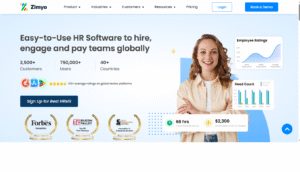
Overview
Zimyo is a modern HRMS designed for schools, universities, and training institutions. It focuses on operational efficiency and employee engagement. The platform automates attendance, payroll, and shift management while providing self-service dashboards for staff. Institutions like Shoolini University use Zimyo to align payroll with overtime rules and simplify HR administration. It offers flexible configurations to meet dynamic education sector requirements.
Key Features
- Biometric and geofenced attendance tracking.
- Flexible shift planning and overtime configuration.
- Automated payroll with statutory compliance.
- Centralized document management for secure storage.
- Grievance redressal system for staff queries.
Pros
- Improves employee engagement with self-service tools.
- Automates complex HR tasks.
- Flexible for different shifts and roles.
- Centralized data management improves efficiency.
- Supports payroll and compliance automation.
Cons
- Pricing varies and requires consultation.
- Advanced analytics may need customization.
- Mobile app features may require setup.
- Limited integrations with some legacy systems.
- Learning curve for first-time users.
Pricing
- Custom pricing based on institution size and modules.
- Demo available for evaluation.
- Core features include HR, attendance, payroll, and self-service.
- Add-ons available for advanced reporting and analytics.
- Enterprise support included.
Why Choose?
Zimyo is ideal for institutions needing flexible and modern HRMS tools. It automates payroll, attendance, and shift management. Staff can access self-service dashboards for better engagement. Centralized HR data improves administrative efficiency. Overall, it streamlines HR tasks while enhancing operational transparency.
7) Kenjo
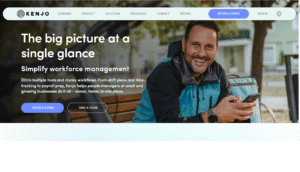
Overview
Kenjo is workforce management software that supports schools, universities, and training institutes. It simplifies HR operations including recruitment, scheduling, attendance, and payroll. The platform also focuses on professional development and staff engagement. By centralizing HR processes, Kenjo enables administrators to manage diverse teams effectively. Institutions benefit from insights into workforce performance through reporting dashboards.
Key Features
- Simplifies recruitment and hiring workflows.
- Automates scheduling, shift planning, and absence management.
- Payroll adjustments for overtime and sick leave handled within the system.
- Learning and development tools track staff training and performance.
- Analytics and dashboards provide insights into workforce efficiency.
Pros
- Centralizes all HR functions in one platform.
- Improves staff engagement and communication.
- Supports flexible scheduling and payroll management.
- Tracks professional development and training.
- Provides actionable analytics for administrators.
Cons
- May be complex for small institutions.
- Pricing requires contacting Kenjo.
- Advanced analytics setup may take time.
- Some features require staff training.
- Limited multi-campus compliance tools.
Pricing
- Custom pricing depending on institution size and modules.
- Core features include HR, payroll, attendance, and training tools.
- Demo available for evaluation.
- Add-ons available for analytics and reporting.
- Enterprise support included.
Why Choose?
Kenjo is ideal for institutions wanting a complete HR solution. It centralizes HR, payroll, and scheduling processes. Staff engagement is improved through learning tools and surveys. Analytics help administrators make data-driven decisions. Overall, it reduces administrative burden while supporting staff development.
8) Workday HCM
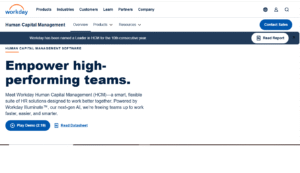
Overview
Workday HCM is an enterprise-level HR and finance solution suitable for large universities and education groups. It integrates human capital management with payroll, talent acquisition, and learning management. The platform allows administrators to manage complex staff structures across multiple campuses. Workday also provides data-driven insights to improve workforce planning and institutional efficiency.
Key Features
- Centralized HR, payroll, and talent management.
- Automated payroll with compliance across regions.
- Integrated learning and development modules for staff growth.
- Workforce analytics and reporting dashboards.
-
Employee self-service for leave, payslips, and updates.
Pros
- Scalable for large multi-campus institutions.
- Deep integration with finance and HR processes.
- Advanced analytics for workforce planning.
- Supports compliance across multiple countries.
- Employee self-service improves engagement.
Cons
- Expensive for smaller institutions.
- Complex setup and implementation process.
- Requires dedicated IT resources for customization.
- Learning curve for first-time users.
- Some features may be overwhelming for mid-sized schools.
Pricing
- Custom pricing based on institution size and modules.
- Demo available on request.
- Includes HR, payroll, talent management, and analytics.
- Mobile access included.
- Add-ons available for learning and performance management.
Why Choose?
Workday HCM is ideal for large universities needing a scalable, integrated HR and finance solution. It streamlines payroll, recruitment, and learning management. Analytics help administrators make informed workforce decisions. Employee self-service improves staff engagement. Overall, it supports complex multi-campus operations efficiently.
9) Oracle HCM Cloud
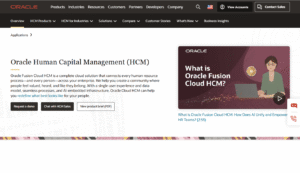
Overview
Oracle HCM Cloud is a comprehensive HR solution for universities and large educational institutions. It combines human capital management with payroll, talent acquisition, and analytics. The platform allows institutions to automate HR processes while maintaining compliance with regional regulations. Oracle HCM Cloud also supports global education providers and multi-campus operations.
Key Features
- Integrated HR, payroll, and talent management.
- Automation of attendance, leave, and performance tracking.
- AI-driven analytics for workforce planning.
- Employee self-service portal for HR tasks.
- Learning and development modules for staff training.
Pros
- Suitable for large and multi-campus institutions.
- Advanced analytics and AI-driven insights.
- Centralized HR data improves decision-making.
- Supports compliance with local labor laws globally.
- Employee self-service boosts efficiency.
Cons
- High cost, not ideal for small schools.
- Implementation can be time-consuming.
- Requires IT expertise for integration.
- May be complex for smaller HR teams.
- Some modules need additional licensing.
Pricing
- Custom pricing depending on modules and institution size.
- Core features include HR, payroll, and talent management.
- Mobile access included.
- Add-ons available for learning and analytics.
- Free demo available upon request.
Why Choose?
Oracle HCM Cloud is perfect for large universities requiring robust HR automation and analytics. It ensures compliance, streamlines payroll, and supports multi-campus operations. Staff benefit from self-service tools for better engagement. Advanced reporting aids strategic HR decisions. The platform is highly scalable and future-proof.
10) ADP Workforce Now
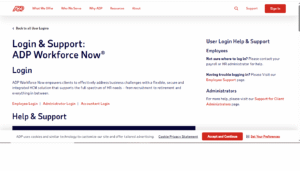
Overview
ADP Workforce Now is an HR and payroll solution designed for schools and mid-to-large educational institutions. It provides a centralized platform to manage HR, payroll, time, and benefits. The system simplifies compliance, automates administrative tasks, and provides reporting insights. ADP is widely recognized for its payroll reliability and employee self-service features.
Key Features
- Payroll automation with tax and compliance management.
- Time and attendance tracking for all staff types.
- Employee self-service for leave, payslips, and benefits.
- Performance and goal management tools.
- Reporting and analytics for HR insights.
Pros
- Trusted payroll system with reliable compliance.
- Reduces administrative burden with automation.
- Employee self-service improves engagement.
- Scalable for mid-to-large institutions.
- Integrated HR and payroll reporting.
Cons
- Pricing may be high for smaller schools.
- Limited customization compared to other platforms.
- Some advanced features require add-ons.
- Learning curve for first-time users.
- Integration with legacy systems can be challenging.
Pricing
- Custom pricing depending on institution size and modules.
- Includes HR, payroll, time, and performance management.
- Mobile access included.
- Add-ons available for advanced analytics.
- Free demo offered on request.
Why Choose?
ADP Workforce Now is ideal for schools and universities looking for reliable payroll and HR automation. It reduces manual HR tasks and improves staff engagement. Reporting and analytics help administrators make informed decisions. Self-service tools empower employees. Overall, it balances automation with ease of use.
Conclusion
Choosing the right HR software for educational institutions is crucial for operational efficiency and staff satisfaction. Large universities with multiple campuses may benefit from enterprise solutions like SAP SuccessFactors or Workday HCM, while mid-sized schools and training institutes may find platforms like BambooHR, Easy HR, or Zoho People more flexible and cost-effective.
Modern HR software reduces manual errors, improves compliance with labor laws, streamlines payroll, and enhances employee engagement through self-service portals. By investing in a reliable HR platform, educational institutions can save time, optimize workforce management, and focus on their core mission: delivering quality education.
Frequently Asked Questions (FAQs)
What is education HR software?
Education HR software is a system designed to manage HR functions in schools, colleges, and training institutes. It automates payroll, attendance, leave, and performance tracking, while centralizing staff records for easy access and compliance.
How does it improve staff performance?
These platforms provide dashboards with real-time analytics on attendance, leave, and productivity. By identifying trends and areas for improvement, administrators can make informed decisions to boost staff performance.
Can education HR software handle multi-campus operations?
Yes. Most modern HR software allows centralized management of employees across multiple campuses. HR teams can access payroll, leave records, and performance reports for all locations in real time.
Is employee self-service available?
Yes. Staff can view payslips, request leave, swap shifts, and update personal information via web or mobile apps, reducing administrative workload and improving transparency.
How does it ensure compliance with labor laws?
Education HR software tracks certifications, licenses, visas, and local labor law requirements automatically. Alerts and notifications help prevent expired documents and maintain legal compliance.
